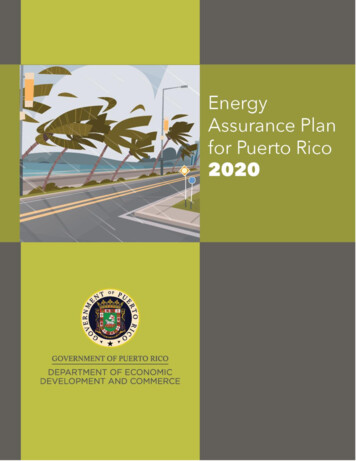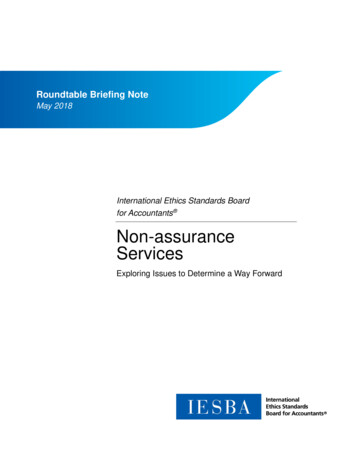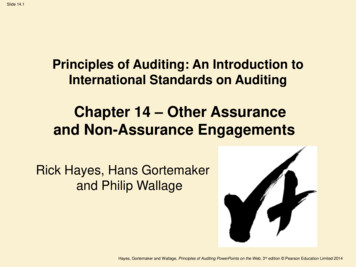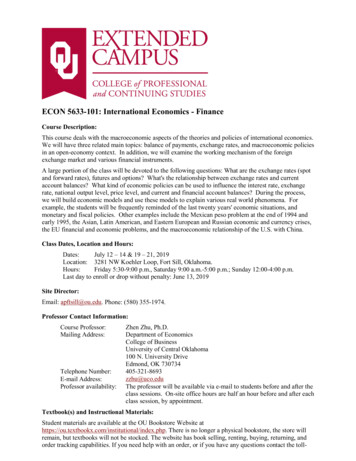
Transcription
Energy Assurance PlanPuerto Rico Energy Public Policy Act – Energy Assurance PlanningGovernment of Puerto RicoJune 30, 2020SUBMITTED BYDepartment of Economic Development and CommerceEnergy Public Policy ProgramSecretary Manuel Laboy RiveraPO Box 40285San Juan, P.R. 00940PRINCIPAL PLANNERArch. Yan Carlo Oquendo Ramos IT, MDSExecutive Director of Energy Policy ProgramPhone: (787) 765-2900, Ext. 5669E-Mail: eaplan@ddec.pr.govSUBMITTED TOOffice of the GovernorHon. Wanda Vázquez GarcedE-Mail: apabon@fortaleza.pr.gov2Energy Assurance Plan for Puerto RicoJune 2020
TABLE OF CONTENTSI. EXECUTIVE SUMMARY6II. INTRODUCTION15A. Nature of Energy Assurance Plan for Puerto Rico .B. Energy Security from an Emergency Management Perspective .C. Significant Energy Emergencies in Puerto Rico .i. Power Blackouts .ii. Hurricanes Irma and María iii. Earthquake 2020 .D. Document Organizational Structure .III. ENERGY ASSURANCE PLAN OBJECTIVESA.B.C.D.1719212123272930Define and clarify stakeholder’s roles: public, private Transparency of information: data access and required infrastructure Understand current electricity profile by the state and identify vulnerabilities .Define response stages for an energy emergency IV. ENERGY SCOPE STATEMENT3031333436A. Local Energy Supply Chain .i. Energy System Overview ii. Generation iii. Transmission iv. Electricity v. Petroleum .vi. Natural Gas vii. Coal .viii. Renewable Energy B. Articulate types of energy critical infrastructure in terms of their responsibilities.i. Operational response from a catastrophic scenario ii. Technological and Man-made Hazards Situations 3636404448515658596162633Energy Assurance Plan for Puerto RicoJune 2020
V. CONCEPTUAL GUIDES AND STRATEGIES66A. Roles, Responsibilities, Plans and Strategiesi. Energy Policy Program of the Department of Economic Development andCommerce: Act 17-2019 ii. Puerto Rico Electric Power Authority: Integrated Resource Plan (IRP) iii. FEMA/COR3: Stafford Disaster Relief and Emergency Assistance Act(Stafford Act) iv. Operational Guides .a. Puerto Rico Emergency Management Bureau (PREMB): JointOperational Catastrophic Incident Plan for Puerto Rico 2018 b. U.S. Government Accountability Office: Puerto Rico ElectricityGrid Recovery 2019 .c. Department of Energy (DOE: Energy Resilience Solutions for thePuerto Rico Grid 2018 .d. NASEO: National Association of State Energy Officials: EnergyAssurance Planning Framework .e. FEMA/DHS: National Preparedness Goal (32 Core Capacities) .f. American Public Power Association: Cyber Incident ResponsePlaybook 2019 .VI. METHODOLOGYA.B.C.D.6667697070707172727374Threat and Hazard Identification and Risk Assessment (THIRA) Stakeholders Preparedness Review .Identify and update current critical infrastructure .Consultation from advocacy group i. U. S. Department of Energy (DOE)ii. Puerto Rico Energy Power Authority (PREPA)iii. National Association of State Energy Officials (NASEO)iv. University of Puerto Rico and Inter American University of Puerto Ricov. FEMA- Threat and Hazard Identification and Risk Assessmentvi. Central Office for Recovery, Reconstruction and Resiliency (COR3)vii. U. S. Department of Homeland Security (DHS)viii. PUMA ENERGYix.Puerto Rico Industrial Development Company (PRIDCO)747576794Energy Assurance Plan for Puerto RicoJune 2020
VII. ENERGY SUPPLY DIAGNOSTICS/SWOT ANALYSIS80A. Mitigating Future Electricity Risks B. SWOT Analysis: Strength, Weaknesses, Opportunities and Threads .i. Energy Assurance Planning .ii. Electricity .iii. Petroleum iv. Natural Gas .v. Coal .vi. Renewable Energy .VIII. PROPOSED STRATEGIES TO RESPOND AND MITIGATE ENERGY DISRUPTIONA. Energy Assurance Planning and Mutual Aid .B. Fundamental Elements on emergency response organization .i. Emergency Support Function (ESF-12) Playbook .ii. Energy Task Force Responsibilities .iii. Private Sector Roles .C. ESF respond coordination at a multiorganizational and multisectoral level .D. Dissemination of information .IX. EAP - PROGRAM EVALUATION AND IMPROVEMENT80818181828282828383848693969899104A. Updating Plan . 104B. Short-term and Long-term EAP Outcomes 105C. Plan Evaluation Mechanism . 107X. CONCLUSION110XI. REFERENCE111XII. TABLE AND FIGURES113XII. APPENDIX1155Energy Assurance Plan for Puerto RicoJune 2020
I. Executive SummaryThe Governor of Puerto Rico has assigned the Puerto Rico Energy Policy Program from theDepartment Economic Development and Commerce (DEDC-EPP), to develop the Island’sEnergy Assurance Plan (EAP) under Act 17-2019. The regulatory compliance involves policymandates that define specific roles of the Energy Policy Program from the DEDC as the leadagency on energy response during an emergency. Based on Act 17 of 2019, the DEDC-EPP hasthe obligation to:“Before each hurricane season, the Department of Economic Development and Commercethrough the Energy Public Policy Program shall coordinate with the agencies andinstrumentalities of the Government of Puerto Rico a revised Energy Assurance Planproviding for the establishment of a standardized Incident Command System (ICS) andIncident Management Team (IMT).” ACT 17-2019Puerto Rico’s only EAP to date was developed in 2012 and submitted to the U. S. Departmentof Energy. This 2020 EAP represents the first response approach from an energy emergencyperspective for the government of Puerto Rico, based on catastrophic experiences thatcreated precedents for FEMA and new guidelines for the Emergency sector of the UnitedStates. The DEDC-EPP strongly believes in the importance of pursuing better energy assuranceplanning to help contribute to the resiliency of the energy sector, including the electricity grid,by focusing on the entire energy supply system, which includes refining, storage, distributionof fossil and renewable fuels, and incorporation of new smart grid technologies.This Plan is a result of collaborative efforts between different public and private entities thatprovided support to existing emergency guidance. A Memorandum of Understanding (MOU)between Department of Economic Development and Commerce (DEDC) and Central Office forRecovery, Reconstruction and Resiliency (COR3) was developed to maintain holisticcoordination with federal and government agencies. The Plan also recognizes current recoveryefforts like the Joint Operational Catastrophic Incident Plan (JOCIP), developed by thePuerto Rico Emergency Management Bureau (PREMB). DEDC-EPP managed a collectiveprocess to assess what is needed to develop a holistic EAP, by maintaining standard levels ofreliability and transparency. Within the Advocacy Group, DEDC-EPP engaged key stakeholders,including:i.ii.iii.iv.v.U. S. Department of Energy (DOE)Central Office for Recovery, Reconstruction and Resiliency (COR3)Puerto Rico Energy Power Authority (PREPA)National Association of State Energy Officials (NASEO)University of Puerto Rico and Inter American University of Puerto Rico6Energy Assurance Plan for Puerto RicoJune 2020
vi.vii.viii.FEMA- Threat and Hazard Identification and Risk AssessmentU. S. Department of Homeland Security (DHS)PUMA ENERGYThe Working Group was part of the development and critical analysis of the EAP. Informationand guidelines suggested for the planning, preparedness, response and recovery wasdiscussed with all different parties at different stages. Nevertheless, the DEDC-EPP recognizesthe limited time of 6 months, within earthquakes and COVID-19, as a limitation for a morecomprehensive approach. The EAP will be updated considering current health crisis of COVID19 and recent announcement of privatization for the transmission and distribution system.New roles and responsibilities that impact the existing Operational Emergency Plan fromPREPA and PREMB’s Joint Operation Catastrophic Incident Plan will need to be updated aswell.Since the last EAP of 2012, Puerto Rico was hit by Hurricanes Irma and María, two of thestrongest storms in recent decades. Hurricane María struck Puerto Rico as an upper levelCategory 4 storm with sustained winds of over 150 mph and rainfall exceeding 24 inches.María devastated the island, which was still in emergency response mode following HurricaneIrma. The situation led to a complete failure of Puerto Rico's electric power grid, transmissionand distribution lines across the island, flooding substations, generation, and distributionfacilities, resulting in the longest duration power outage in U.S. history1.The DEDC-EPP recognizes that the Puerto Rico EAP must reflect and address the uniquelessons learned from recent hazards and threats that Puerto Rico has faced. Accordingly, theDEDC-EPP approached this effort with an interest in actively collaborating with local and statestakeholders in Puerto Rico, including the government-owned electric utility, wholesale fuelproviders, consumer representatives, and other Island governmental agencies. This holisticapproach includes shared responsibilities between the private sector, non-governmentalorganizations, and other government entities under the National Response Framework calledEmergency Support Functions. The term “energy”, under ESF #12, includes producing, storing,refining, transporting, generating, transmitting, conserving, building, distributing,maintaining, and controlling energy systems and system components2.Regardless of the reason for the energy disruption, if the petroleum, electricity or natural gassectors are impacted, there will be cascading impacts on other critical infrastructure, whichheightens the need for decisive action from the state to address the shortage situation. Ashortage exists whenever the Governor receives notification by the Department of EconomicDevelopment and Commerce of an increase in the demand for any petroleum product or thereis a decrease in the available supply for the petroleum product. This situation may cause a7Energy Assurance Plan for Puerto RicoJune 2020
major adverse impact on the economy, public order, or the health, welfare, or safety of thepeople of Puerto Rico, and may not be responsibly managed within the distribution system.These interdependencies constitute a “system of systems” in which the failure of one ormultiple infrastructure elements can cascade and affect the resilience of the entire system.Figure 1 Energy InterdependencyThe EAP provides an extensive perspective of critical infrastructure sectors rather thanworkers. It also includes stakeholders who support crucial supply chains for criticalinfrastructure. The industries they support represent, but are not limited to, medical andhealthcare, telecommunications, information technology systems, defense, food andagriculture, transportation and logistics, energy, water and wastewater, law enforcement, andpublic works.State, local, tribal, and territorial governments are responsible for implementing andexecuting response activities, while the Federal Government is in a supporting role. The EAPestablishes an energy disruption emergency response structure, while adhering to relevantpublic health guidance. The critical infrastructure owners and operators are expected to use8Energy Assurance Plan for Puerto RicoJune 2020
their own judgement on issues of the prioritization of business processes and workforceallocation to best ensure continuity of the essential goods and services they support.All decisions should appropriately balance public safety, the health and safety of theworkforce, and the continued delivery of essential critical infrastructure services andfunctions.The U.S. Department of Homeland Security’s (DHS) Cybersecurity and Infrastructure SecurityAgency (CISA) provides roadmaps to secure essential critical infrastructure during anyemergency2. Consistent with these authorities, CISA has developed, in collaboration with otherfederal agencies, State and local governments, and the private sector, an “Essential CriticalInfrastructure Workforce” advisory list. This list is being used to protect local communities,while ensuring continuity of functions critical to public health and safety, as well as economicand national security of Puerto Rico.The island is required under Federal Homeland Security funding guidance to implement theNational Incident Management System (NIMS). As the local government develop their criticalinfrastructure plans, each Governor has designated a State administrative agency to supportthe development of homeland security strategies, implement strategic goals and objectives,and administer Federal preparedness assistance. The National Association of State EnergyOfficials (NASEO), in collaboration with the National Association of Regulatory UtilityCommissioners (NARUC), has produced Energy Assurance Guidelines that outline States’overall role in energy assurance. This role includes op
viii. PUMA ENERGY The Working Group was part of the development and critical analysis of the EAP. Information and guidelines suggested for the planning, preparedness, response and recovery was discussed with all different parties at different stages. Nevertheless, the DEDC-EPP recognizes










